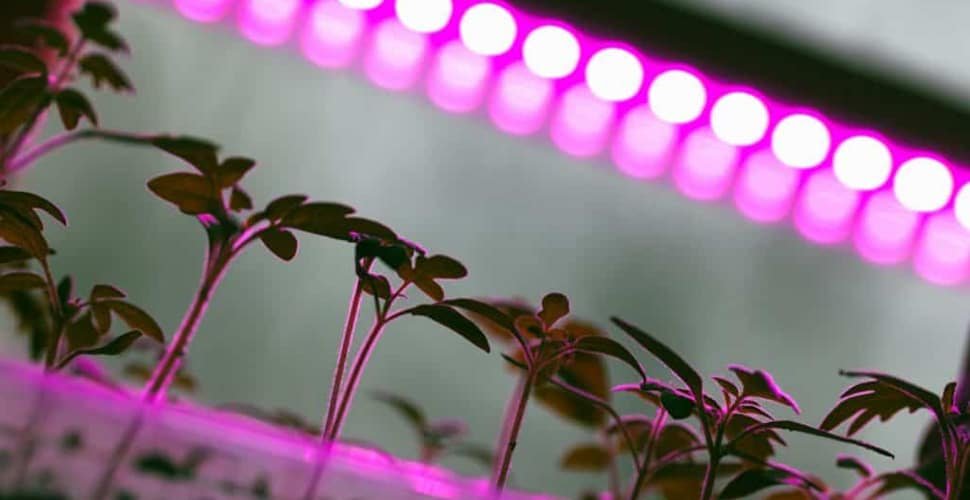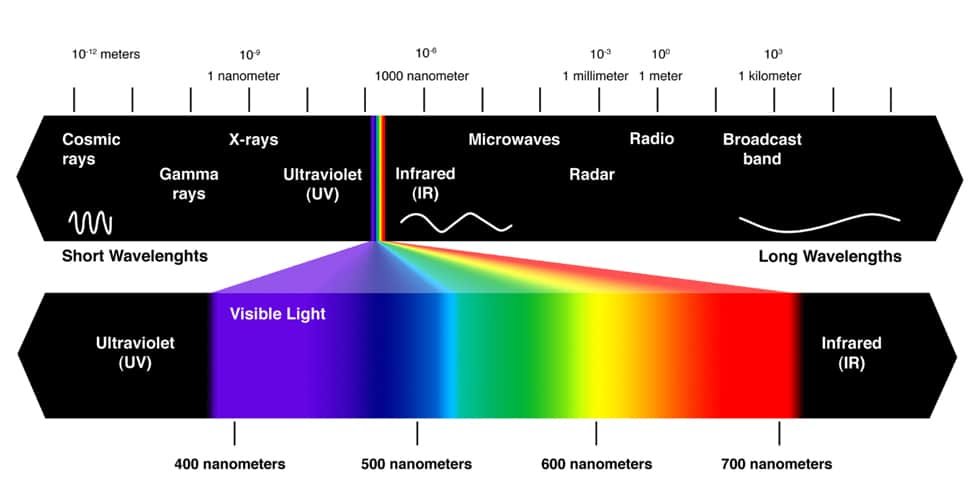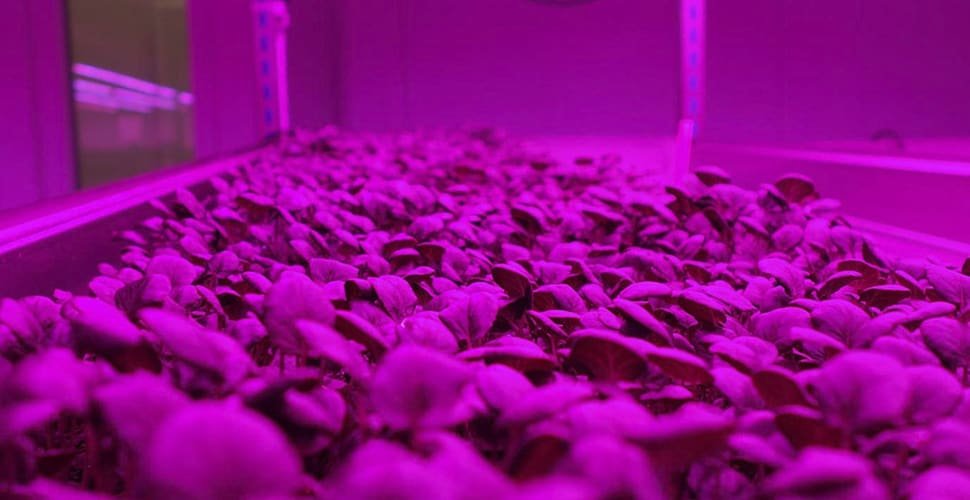목차
Today, indoor grow lights are an essential presence for indoor plant cultivation, and you will see them everywhere.
Have you ever noticed an interesting phenomenon? Plants grow well and healthy in natural light that doesn’t seem to have any color, but why are grow lights purple and some look like white?
In fact, LED lights are not purple, they just look purple in our eyes. Since indoor growing lights emit high-intensity blue and red light, which is a mixture of blue and red wavelengths in the color spectrum, this is the purple LED meaning. Specifically, the blue wavelengths of light are important for vegetative growth while the red wavelengths are important for flowering and fruiting.
In this article, we will discuss the reasons behind the purple LED grow lights and whether it is worth it. Let’s dive in!

What Makes Plant Grow Lights Purple?
LED lights are made up of various combinations of wavelengths that will produce the light you provide for your plants. But there is more than just one wavelength for any given color set. Plant growth light manufacturers will pinpoint specific color wavelengths that are beneficial to plant growth to create LED planting lights. Their goal is to create light that is beneficial to your indoor plants and try to avoid light that the plants don’t need.
Wavelength And Color

Blue light wavelength is between 430 and 500 nm.
Red light wavelengths are between 625 and 740 nm.
UV wavelengths are between 100 and 450 nm.
There are three types of UV wavelengths, two of which are used in growth chambers: UV-A and UV-B.
- UV-C: 100 to 290 nm.
- UV-B: 290 to 320 nm.
- UV-A: 320 to 400 nm.
Far Red wavelengths are between 740 and 1050 nm.
The purple color emitted by LED lights is a combination of the blue and red wavelengths of light that make up most LEDs. Research has shown that both wavelengths are critical in plant development, which is why LED grow light manufacturers use multiple red and blue wavelengths in their grow lights.
Blue Light Wavelength
- Blue light wavelengths promote plant health by regulating growth.
The blue color of grow lights inhibits stem elongation, and it is beneficial for plants that are dwarf. The stems of foliage plants exposed to blue light are shorter and the leaves of these plants are dark green.
Therefore, the light in the blue range will also affect the thickness of the leaves and the chlorophyll content present. You will be able to produce plants with thicker, larger and darker green leaves depending on the spectral needs of the plant.
- Blue wavelength also affects leaf coloration.
A houseplant with purple leaves like a forest pansy needs blue radiation. Otherwise, it may produce green leaves without blue light. Likewise, leafy greens like kale and broccoli will produce healthier nutrients with sufficient blue light, getting more adequate amounts of nutrients like vitamins or antioxidants.
- Blue light controls the flowering of plants.
High-intensity light of 20 μmol can flower long-day plants such as spinach, kale and celery. It can also inhibit flowering for short-day plants such as chrysanthemums and Clivia.
Red Light Wavelength
- Red light wavelengths drive photosynthesis for better plant growth.
In other words, red light has the highest efficiency in converting electricity into photosynthetic photons. This is because red light is usually absorbed more strongly by the green pigments in plants.
Plants exposed to more red light will grow taller. You can use red light to promote or inhibit stem extension. They can also produce thinner leaves and larger, taller plants.
팁: You need to be aware that you must control the red light because too much of it can cause plants to be too tall and slender.
- It is responsible for increasing the rate of photosynthesis in plants.
The red light from purple growing lights also affects plant flowering, and it is through a red light that plants get the most energy.
Combination of Blue and Red Light Wavelengths
Individually, blue light helps plants grow, while red light helps flowering and photosynthesis. Yellow and green absorb the least. Plants reflect this light and are therefore green in color.
However, top grow light manufacturers do not make plant lights that contain all wavelengths during the production process. Because plants do not absorb all light equally. And they will choose the correct and specific light color and you will make the most of your LED indoor grow lights. Use the right lights to save large amount of electricity.
The combination of blue and red light wavelengths provides your plants with the light needed to stimulate all growth patterns simultaneously, which is exactly what your plants need to thrive.
Their combination is important as it allows the plants to follow circadian rhythms even indoors. Allowing the plants to almost know when to perk up and when to rest, just as they do in life outdoors.
After choosing the right grow lights for indoor plants, you must also pay attention to the distance you place them, the right place to hang them and how to use them to maximize output.
Economic Considerations

Purple Grow Lights Do Not Make Economic Sense for Home Growers
From a commercial standpoint, red and blue LED chips are the cheapest to purchase. Early manufacturers of plant grow lights would use this particular combination of spectra to formulate any light recipe they wanted. Because LEDs were expensive at the time, some manufacturers focused only on providing those red and blue lights that were absolutely critical to plants.
But in the last decade, the cost of LED technology has fallen, and the cost of manufacturing and operating these lights has dropped dramatically.
Today, a typical 10-30W blue or red light for plants costs less than $20 per year for electricity. Compared to a full-spectrum plant light of the same wattage today, the electricity savings of a purple plant light is only a dollar or two less per year than a full-spectrum one.
The difference in electricity savings is not large enough to make the economics of purple plant grow lights meaningful to home growers.
Today, an ordinary 10-30W indoor purple grow light costs less than $20 per year for electricity. Compared to a full spectrum grow light of the same wattage today, the electricity savings of a purple plant light is only a dollar or two less per year than a full-spectrum one. The difference in electricity costs is not significant. So, we don’t think the economics of purple plant grow lights make sense for home growers.
But if you plan to use this purple light for plants throughout the warehouse and run vertical farming operations, then it may be of more meaningful value. Purple light benefits a lot, but given its other drawbacks of it, we don’t think this is as important as it used to be.

The Red and Blue Spectrum is Not Unique
Thanks to researchers in this field, the research and science of how plants respond to light over the past 20 years have enriched our knowledge of light.
- UVA / UVB affects essential oils, flavors and fragrances.
- Greenlight is very good at the canopy and leaf penetration, outperforming red and blue.
- Far-red is a particularly good complement to blue, and it helps to enhance plant cell expansion.
Purple Grow Lights are Not Pleasant
There is a standard for how comfortable or pleasant light is to the human eye that we call the CRI, or color rendering index. Simply put, CRI determines how natural the color of an object looks under different kinds of lighting.
If the light looks strange to the human eye, is too sharp and looks unnatural, its CRI value is low. This may also mean that it is simply a combination of red and blue LED chips.
We also learned that purple grow lights emit a narrow spectrum of light, providing plants with the specific wavelengths of light they need to grow and thrive. Although red or blue light for plants is suitable for indoor gardening, its color temperature can make people less comfortable for long periods of time. This can lead to eye strain or headaches. If you also use the purple plant light, it is recommended that you bring your glasses, even if they are very ordinary sun shades, during use.
In contrast, light that looks naturally pleasant to the human eye has a high CRI value and may be made up of many different color combinations of LED chips.
Sum Up
Hopefully, by now, you have found the answer to Why are Grow Lights Purple? And hopefully, this article will answer the question of whether it is worthwhile for you to buy a purple plant lamp.
Today, most grow lights are no longer purple. In our opinion, a better choice is a full spectrum LED grow light that will ensure optimal plant health and a more comfortable environment.
If you live in a very hot area and want the inside of your house to feel cooler, look for lights rated at 5000-5500K. The spectral distribution of these lights leans toward blue and the temperature of the grow lights will be relatively cooler.
When you live in a cooler climate or have a smaller space, we recommend a warmer light temperature in the 2700 – 3500K range. These are skewed red and have a warmer glow, arguably better for fruiting and flowering.
If you want to learn more about finding the perfect plant grow light for your indoor plants, we recommend 전체 스펙트럼 LED 조명은 식물에 좋은가요??
제이스
AUXGROW의 디지털 마케팅 관리자인 Jayes는 수경 재배 시스템에 대한 열정과 LED 재배 조명에 대한 전문 지식을 결합합니다. 실무 경험과 깊은 이해를 바탕으로 Jayes는 지속 가능한 재배의 세계로 여러분을 안내합니다.





